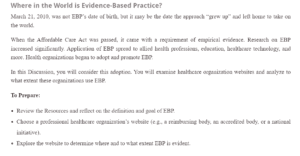Where in the World is Evidence-Based Practice?
Evidence-based practice (EBV) is the concept that all occupational practices, such as nursing care or medicine in general, must use scientific evidence to make critical decisions (Melnyk & Fineout-Overholt, 2018). This simply implies that all decisions made by care practitioners, such as nurses or physicians, and healthcare organizations should be based on empirical or scientific evidence/facts rather than just mere personal intuition or hearsay (Crabtree et al., 2016). Although the term evidence-based practice in healthcare was first introduced in 1992, its widespread use in the U.S. was popularized when Obama first signed the Affordable Care Act into law in 2010 (Boller, 2017). Since then, evidence-based practices have spread to healthcare technology, education, and different allied health professions. In fact, most care organizations have fully adopted and implemented EBV practices.
One such healthcare institution is the Mayo Clinic, which is regarded as one of the world’s biggest and most popular non-profit academic medical centers. Located in three major metropolises in different parts of the U.S., including Scottsdale (Arizona), Jacksonville (Florida), and Rochester (Minnesota), Mayo Clinic is a renowned healthcare center that integrates research, education, and patient care. With an annual expenditure of nearly $660 million on research, the institution boasts nearly 3,000 researchers, 58,400 administrative personnel, and 4,500 physicians (Mayo Clinic, n.d.). Acknowledging the importance of using scientific evidence as the core of its patient care, education, and research, Mayo Clinic is an organization that is centered on using empirically proven practices, methods, and procedures. The institution’s mission and vision statements read as “Mayo Clinic will provide an unparalleled experience as the most trusted partner for health care” and “To inspire hope, and contribute to health and wellbeing by providing the best care to every patient through integrated clinical practice, education, and research,” respectively (Mayo Clinic, n.d.). The aspect of evidence-based practice is clearly stated as “the most trusted” (vision statement) and the “research” (mission statement). Mayo Clinic acknowledges the fact that integrating research into the institution’s education and healthcare practices is the only surest way of creating a trustworthy and reliable organization. Finally, I believe the information on the institution’s website has significantly changed my view of the services, especially the reliability offered. I say so because the institution invests millions into research yearly to ensure that all the methods, procedures, practices, and decisions made are based on empirical evidence.
References
Boller, J. (2017). Nurse educators: Leading health care to the quadruple aim sweet spot. Journal of Nursing Education, 56(12), 707–708. doi:10.3928/01484834-20171120-01
Crabtree, E., et al. (2016). Improving patient care through nursing engagement in evidence-based practice. Worldviews on Evidence-Based Nursing, 13(2), 172–175. doi:10.1111/wvn.12126
Mayo Clinic. (n.d.). Mission, vision, and value statements. Retrieved from https://www.mayoclinichealthsystem.org/locations/eau-claire/about-us/mission-vision-and-value-statements
Melnyk, B. M., & Fineout-Overholt, E. (2018). Evidence-based practice in nursing & healthcare: A guide to best practice (4th ed.). Philadelphia, PA: Wolters Kluwer.
ORDER A PLAGIARISM-FREE PAPER HERE
We’ll write everything from scratch
Question 
Where in the World is Evidence-Based Practice?
March 21, 2010, was not EBP’s date of birth, but it may be the date the approach “grew up” and left home to take on the world.
When the Affordable Care Act was passed, it came with a requirement of empirical evidence. Research on EBP increased significantly. Application of EBP spread to allied health professions, education, healthcare technology, and more. Health organizations began to adopt and promote EBP.
In this Discussion, you will consider this adoption. You will examine healthcare organization websites and analyze to what extent these organizations use EBP.
To Prepare:

Where in the World is Evidence-Based Practice
- Review the Resources and reflect on the definition and goal of EBP.
- Choose a professional healthcare organization’s website (e.g., a reimbursing body, an accredited body, or a national initiative).
- Explore the website to determine where and to what extent EBP is evident.
Post a description of the healthcare organization website you reviewed. Describe where, if at all, EBP appears (e.g., the mission, vision, philosophy, and/or goals of the healthcare organization, or in other locations on the website). Then, explain whether this healthcare organization’s work is grounded in EBP and why or why not. Finally, explain whether the information you discovered on the healthcare organization’s website has changed your perception of the healthcare organization. Be specific and provide examples.
